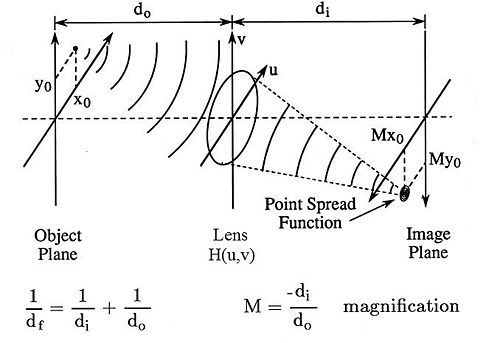Space Domain Models for Optical Imaging Systems
keyword: ECE 637, digital image processing
Imaging systems are well approximated by linear space invariant systems theory, which is why we will use it to describe imaging systems.
We can characterize the lens for a given aperture by its impulse response. Its Point Spread Function (PSF) is analogous to its impulse response since the PSF describes the system's response to a point input (think about a point input as $ \delta (x,y) $).
The PSF will be denoted by the function $ h(x,y) $ in the space domain. Its CSFT will be given by $ H(u,v) $.
Ideally, a point input, would be represented in an image as a single pixel. Let this ideal image be $ f(x,y) $. Consider this to be the input to your imaging system.
Your actual image of the point input however, will be reproduced as something other that a single pixel. This is the output of your imaging system. Let the output of the system be $ g(x,y) $.
So the image you form on the focal plane array is given by the convolution of the ideal image you should have formed with the PSF of the system.
$ \begin{align} g(x,y) &= \int_{-\infty}^{\infty}\int_{-\infty}^{\infty}f(\xi,\eta)h(x-M\xi,y-M\eta)d\xi d\eta \\ &= \frac{1}{M^2} \int_{-\infty}^{\infty}\int_{-\infty}^{\infty}f(\frac{\xi}{M},\frac{\eta}{M})h(x-\xi,y-\eta)d\xi d\eta \end{align} $
so if you take away the magnification factor, the resulting image is likt the convolution of what the image should have been with the psf of the system
$ g(x,y) = \frac{1}{M^{2}} h(x,y)* \tilde{f} (x,y) $
the psf is h(xy) and its CSFT is gonna be H(uv)
$ CSFT \{ h(x,y) \} = H(u,v) $
and H(uv) characterizes hte imaging system. Real imaging systems are not perfectly space invariant as you move around on the image plain the osf will be diffrerent. one way you can measure this if you have a camera you can actually go out and do this go out on a starry evenign and put it on a tripod and look at some of the starts in the sky because stars are like perfect point sources. and then you'll get an image and it'll have points on it. you can put that image on your computer and zoom in on and you;ll see that when you zoom into a point it's not really pint but a blur. its a few pixels wide. and you can try this with dofferent apertures and you;ll see that if you use f16 the blur will get bigger. f3 the blur will be smaller ie if the camera is in focus. you have to set it to infinity focal distance. so this psf you've essentailly put the delta function $ \delta (x,y) $ because the star is like a delta function and what you've got out is the psf of the system. if you take the fourier transform of that you'll get the frequency response of the system.
now often people dont worry too much about the phase. what they'll mostly focus on is the magnitude of this thing. so you have
$ CSFT\{h(x,y)\} = H(u,v) $
if
$ \begin{align} h(x,y) &= h(-f,-y) \\ \Rightarrow H(u,y) &\in \mathbb{R} \end{align} $
In other words, if $ h(x,y) $ is an even function then H(u,v) is real.
Often people are more interested in the magnitude of $ H(u,v) $ normalized by $ H(0,0) $. This function is called the Modular Transfer Function (MTF) of the system. It is the absolute value of the Optical Transfer Function (OTF) for the system. so we have that
$ \begin{align} OTF &= \frac{H(u,v)}{H(0,0)} \\ \Rightarrow MTF &= |\frac{H(u,v)}{H(0,0)}| \end{align} $
Recall that
$ H(0,0) = \int_{-\infty}^{\infty} h(x,y) dxdy $
ie $ H(0,0) $ is equal to the area under h(x,y)
if you plot the MTF you in 1D for instance along the u axis, it'll look like this (insert figure) and you can look at the cutoff frequency, and the unites are in cycles per inch along the u axis. and that'll give you an idea of the highest frequencies that the system can pass. so you might have the halfway point or 3 dB down. so this how you often characterize the spatial resolution of your imaging system. if you have a wider MTF you have higer resolution.. f you have a narrower mTF you have lower resolution and the psf is larger (larger in the frequency domain corresponds to smaller in the space domain).


